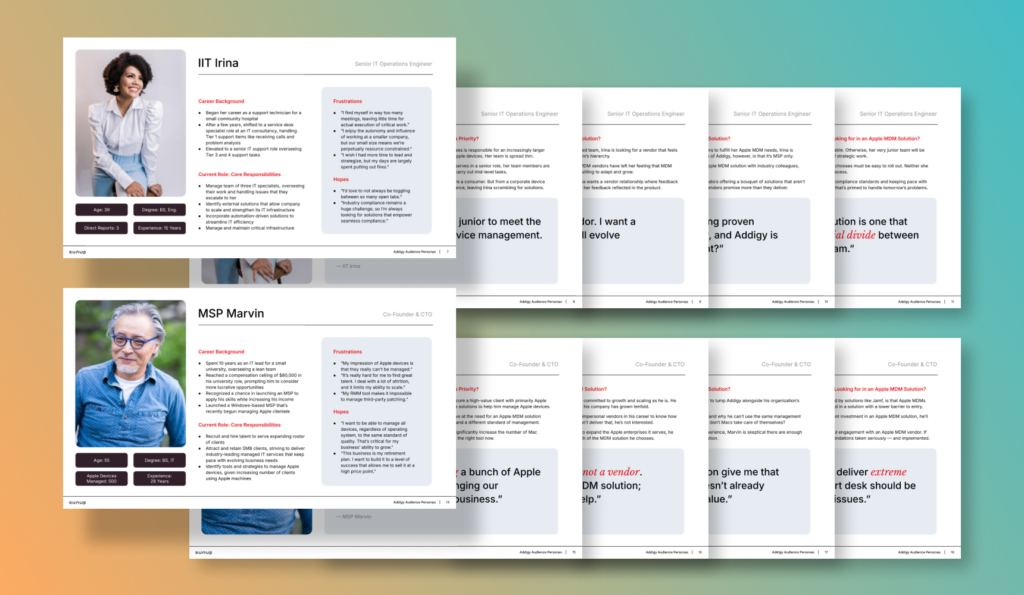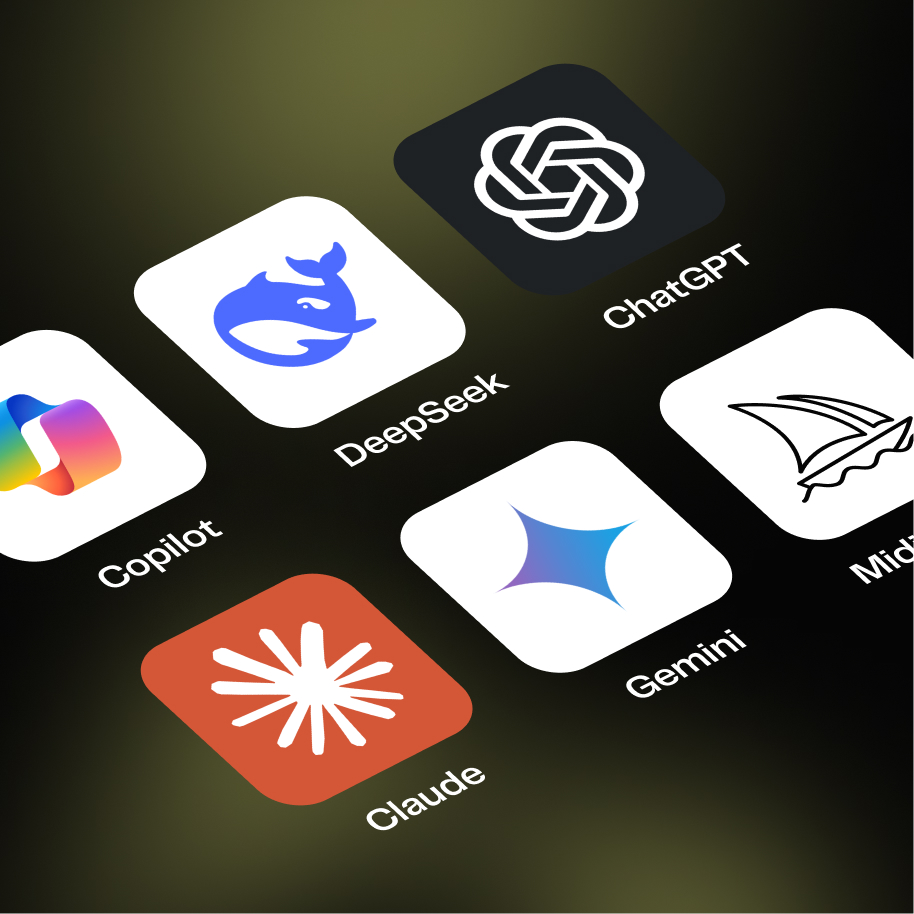Brand personas (aka marketing personas or buyer personas) and brand personality: These are terms that get tossed around a lot in meetings. But what’s the difference between them?
Understanding the distinction and intentionally developing each for your organization is an important step in taking your brand from generic to genuine.
What is a marketing persona?
Simply put, a marketing persona is the person you’re talking to.
Marketing (or brand) personas are detailed portraits of the audience you want to reach. Think of them as fictional characters based on real data.

Whether you call them a brand persona, a marketing persona or a buyer persona what matters is that you define your target audience with quality market research and creative empathy.
Develop these personas just as an actor creates a well-rounded character: Who, specifically, are you selling to, and what is that person looking for? What motivates them, and how do they move through the sales journey?
A well-developed brand persona in B2B typically includes the following based on who is most likely to buy from you:
- Demographics (age, location, income level)
- Firmographics (job title, industry, experience)
- Psychographics:
- Pain points and challenges (What keeps them up at night?)
- Goals and aspirations (What are they looking for in their role?)
- Buying behaviors and preferences (What work purchases have they made? Do they have decision-making power? Who are the stakeholders?)
- Where they get their information (news sources, social media channels, word of mouth)
Not every buyer persona has to include every bit of the information above — just the information that matters most when you’re trying to figure out how to say what you need to say to the person you need to say it to.
Why bother creating these fictional personas? Because they transform your audience from an abstract concept into someone you can actually visualize and understand. A clear persona helps you put yourself in a customer’s shoes. It allows you to ask, “If I were this person, would I care about this feature? And if so, how would I find out about it? What would I want to hear?”
For example, let’s say you work for a startup that sells a project management solution. You might create a marketing persona like Marketing Director Maria. She’s 38, lives in the Cleveland suburbs, works at a mid-sized B2B company, feels overwhelmed by new technologies, values efficiency above all else and makes decisions based on peer recommendations and industry reports. She has to get her boss’ approval before making a major purchase decision. She wants a project management solution that works, and she wants her manager to know she made a good recommendation on the technology.
Understanding Maria would shape your branding strategy in specific ways:
- Messaging focus: Your marketing would emphasize simplicity and proven results rather than cutting-edge features. Headlines might highlight benefits like “project management made simple” or proof points like “the solution trusted by 80% of Fortune 500 marketing directors.”
- Content strategy: You’d create case studies from similar mid-sized B2B companies and testimonials from other marketing directors. You’d also develop easily shareable ROI calculators and comparison charts that Maria could forward to her boss.
- Visual cues: Not every tech startup needs an image of the Golden Gate Bridge and a slick-looking office on the slide about their headquarters. In fact, Maria might prefer to see a more down-to-earth office space.
- Touchpoints: Knowing Maria relies on peer recommendations, you’d invest heavily in customer advocacy programs and industry-specific review sites.
- Sales approach: Your sales team would be prepared with documentation that helps Maria make the internal case, including presentation templates and FAQ/objection-handling guides specifically designed for conversations with senior management.
- Customer experience: Post-purchase, you’d provide Maria with implementation support that makes her look good, including regular progress reports she can share upward and early wins she can showcase. Maybe you’d send her a nice note with a personal touch.
The level of detail we developed for the Maria persona transforms abstract marketing strategies into concrete decisions about where to invest, what to communicate and how to support the entire customer journey.
What is brand personality?
Simply put, brand personality is who you are when you’re talking.
If marketing personas represent who you’re talking to, brand personality defines who you are when you speak.
Your brand personality includes:
- Core brand values and beliefs
- Verbal identity, including voice and tone (formal versus casual, serious versus humorous, authoritative versus collaborative)
- Visual identity (colors, typography, imagery style, design principles)
Consider how different brand personalities play out in the real world.
Apple’s minimalist, innovative personality comes through in everything from its clean store designs to its simple product names. Meanwhile, Wendy’s irreverent, bold personality shines in its sassy social presence and its “fresh, never frozen” positioning (which, by the way, they’ve maintained since 1969).

But recognizable brand personality isn’t just for consumer brands with massive budgets. B2B companies carve out distinctive personalities too — often to great effect in crowded markets.
Slack distinguished itself with a friendly, helpful personality in conversational interface messages and playful illustrations. Mailchimp built a brand with a touch of quirky humor (remember its high-five after sending a campaign?).
A well-defined brand personality typically does three crucial things:
- It creates recognition across channels and over time.
- It builds emotional connection beyond functional benefits.
- It guides decision-making across an organization.
Your brand personality is the foundation of consistent communication that builds recognition and trust. When your team debates whether something “feels like us,” this is what they’re talking about. Brand personality can flex over time, but it needs to be well established and understood by all team members at any given moment.
Making brand personas and brand personalities work together.
Marketing personas and brand personality are two sides of a great conversation. Here’s how they work together in practice:
- Content creation: Your brand personality determines your overall approach, while your marketing persona guides specific topics and pain points to address.
- Channel selection: Your marketing persona tells you where to show up, while your brand personality ensures you show up consistently.
- Campaign messaging: Your marketing persona helps you choose relevant benefits to highlight, while your brand personality dictates how you’ll express those benefits.
- Visual design: Your brand personality sets your visual identity, but understanding your marketing persona helps you select images and design elements that will resonate.
The marketing magic happens when you maintain a consistent brand personality while tailoring your specific messages to each of your marketing personas (and not too many — see below.).
Keep it simple, keep it consistent.
We say this with love and from lived experience: Don’t go overboard. It’s easy to overcomplicate both marketing personas and brand personality. As you develop these essential elements, don’t fall into the trap of doing the most rather than doing what makes sense.
Here are two rules to keep in mind:
- Less is more. Focus on two to three core marketing personas that represent your most valuable customer segments. You can’t be everything to all people. But you can be the right thing for your specific target customers.
- Know thyself. If your brand is wacky on social media but formal in emails, you’ll confuse everyone. Consistency in brand personality doesn’t mean showing up identically on every channel or in every piece of communication — but your brand should be coherent enough to be recognizable wherever it is.
Remember: It’s better to have a few well-defined personas and a clear brand personality than to try to reach fringe audiences with an inconsistent brand. When in doubt, refine rather than expand.
The power of getting personas and personality right in marketing.
When you understand both whom you’re talking to and who you are when you speak, your marketing will reach the sweet spot everyone’s aiming for these days: authenticity.
Customers can sense when a brand truly understands their needs and is able to meet them where they are. You literally can’t fake it.
Start by asking these questions:
- Do we have clearly defined marketing personas based on real customer data?
- Can everyone on our team describe our brand personality in consistent terms?
- Are we adjusting our messaging for different marketing personas while maintaining our brand voice?
Answer these questions honestly, and you’ll be on your way to create marketing that resonates with the right people in the right way.
Ready to spark the perfect connection between your marketing personas and your brand personality? Get in touch today.



